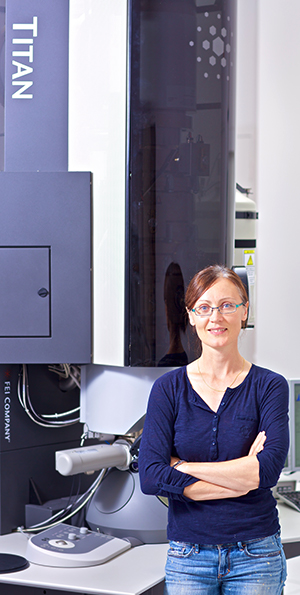The race is on to discover the secret properties of materials at the nanoscale and harness them for the development of new technologies. Gallium (Ga) is used in electronics and circuits involving microwaves, infrared and high-speed switching. In its ordinary ‘bulk’ form it is a soft, silvery bluish metal that melts at 30°C and becomes hard and brittle at sub-zero temperatures. But how does it behave at the nanoscale?

Dr Alexandra Suvorova, AMMRF (now Microscopy Australia) at UWA
By experimenting with gallium nanoparticles, an international team of researchers, including Dr Alexandra Suvorova at the University of Western Australia (UWA) observed for the first time the coexistence a solid and a liquid phase of the same material at the nanoscale. When gallium nanoparticles sit on a sapphire surface, they form a solid core surrounded by a liquid outer layer (top image). This arrangement stays stable even over a temperature range of more than 600°C. Dr Suvorova visualised this highly unusual phenomenon with transmission electron microscopy in the AMMRF at UWA. The expertise involved in this visualisation has been recognised in Physics Today.
The coexistence of a liquid and solid state has been predicted theoretically, and observed indirectly only in narrow temperature ranges. With this new finding, phase diagrams can be developed to plot how these materials behave at the nanoscale.
A/Prof.Nicola Gaston from the University of Auckland says “…the TEM images alone are reason enough for excitement. Interfaces buried in the interiors of metal nanoparticles are both notoriously difficult and important to study. This is the first (confirmation of) theoretical predictions that Ga’s solid–liquid interfaces are not atomically abrupt but roughly four atoms thick. The quality of the experimental images is fantastic.”
Useful in ultraviolet sensors, molecular sensing devices and enhanced photodetectors.
“(We) need to reconsider all our presumptions about solid–liquid equilibrium. At a more applied level, the results hold much promise for future nanotechnology applications.” – News and Views, Nature Materials
Maria Losurdo, et al., 2016 Nature Materials, DOI: 10.1038/nmat4705
Right: High resolution TEM image. Left: The black sphere in the centre is solid gallium within within a liquid drop, atop a sapphire base. The sapphire base is rigid with a relatively high surface energy. As the nanoparticle and sapphire try to minimise their total energy, this combination of properties drives the formation and coexistence of the two phases.
November 27, 2016